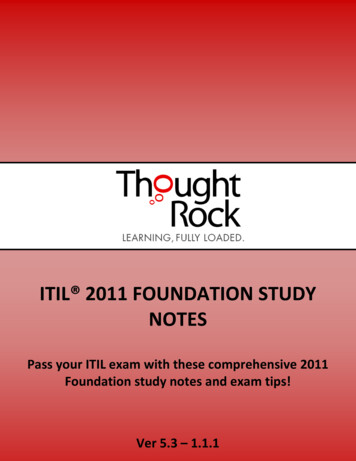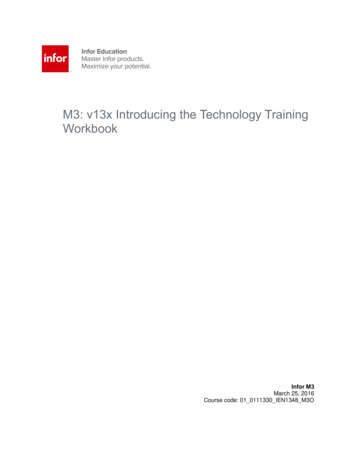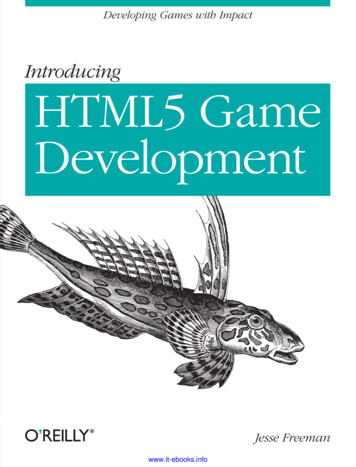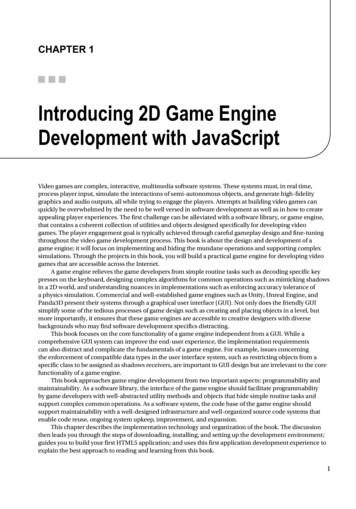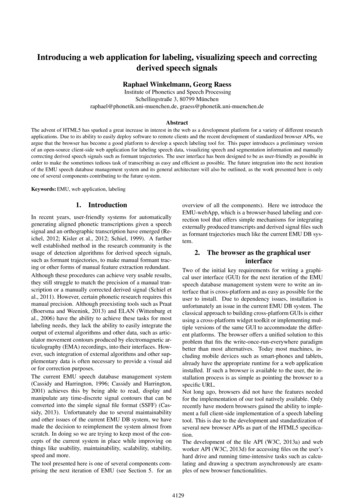
Transcription
INTRODUCINGCHRISTIANDOCTRINETHIRD EDITIONM i l l a r d J. E r i c k s o nE D I T E D B Y L . A R N O L D H U S TA DKMillard J. Erickson, Introducing Christian Doctrine, 3rd EditionBaker Academic, a division of Baker Publishing Group, 1992, 2001, 2015. Used by permission.(Unpublished manuscript—copyright protected Baker Publishing Group)
1992, 2001, 2015 by Millard J. EricksonPublished by Baker Academica division of Baker Publishing GroupP.O. Box 6287, Grand Rapids, MI 49516-6287www.bakeracademic.comPrinted in the United States of AmericaAll rights reserved. No part of this publication may be reproduced, stored in a retrievalsystem, or transmitted in any form or by any means—for example, electronic, photocopy,recording—without the prior written permission of the publisher. The only exception isbrief quotations in printed reviews.Library of Congress Cataloging-in-Publication DataErickson, Millard J.Introducing Christian doctrine / Millard J. Erickson ; L. Arnold Hustad, ed. —Third Edition.pages cmIncludes bibliographical references and index.ISBN 978-0-8010-4919-4 (cloth)1. Theology, Doctrinal. I. Hustad, L. Arnold, editor. II. Title.BT75.3.E73 2015230—dc23 2015003286Unless otherwise indicated, Scripture quotations are from the Holy Bible, New InternationalVersion . NIV . Copyright 1973, 1978, 1984, 2011 by Biblica, Inc. Used by permissionof Zondervan. All rights reserved worldwide. www.zondervan.comScripture quotations labeled KJV are from the King James Version of the Bible.Scripture quotations labeled NIV 1984 are from the 1984 edition of the NIV.Scripture quotations labeled NRSV are from the New Revised Standard Version of the Bible,copyright 1989, by the Division of Christian Education of the National Council of theChurches of Christ in the United States of America. Used by permission. All rights reserved.Scripture quotations labeled RSV are from the Revised Standard Version of the Bible,copyright 1952 [2nd edition, 1971] by the Division of Christian Education of the NationalCouncil of the Churches of Christ in the United States of America. Used by permission.All rights reserved.15161718192021 7654321Millard J. Erickson, Introducing Christian Doctrine, 3rd EditionBaker Academic, a division of Baker Publishing Group, 1992, 2001, 2015. Used by permission.(Unpublished manuscript—copyright protected Baker Publishing Group)
In memory ofSiri Mahal Erickson InoferioJanuary 24–October 14, 1991“Jesus said, ‘Let the little children come to me,and do not hinder them,for the kingdom of heaven belongs to such as these.’”(Matthew 19:14)Millard J. Erickson, Introducing Christian Doctrine, 3rd EditionBaker Academic, a division of Baker Publishing Group, 1992, 2001, 2015. Used by permission.(Unpublished manuscript—copyright protected Baker Publishing Group)
ContentsPreface xiiiPart 1 Introduction1. What Is Theology? 3Differing Assessments of the Value of GeneralRevelation 29The Nature of Theology 4General Revelation and HumanResponsibility 35The Method of Theology 7Implications of General Revelation 362. Contextualizing the ChristianMessage 13The Contemporary Context of Theology 144. God’s Particular Revelation 39The Definition and Necessity of SpecialRevelation 40Approaches to Contextualizing the ChristianMessage 15The Style of Special Revelation 41The Permanent Element in Christianity 16The Nature of Contextualization 18Special Revelation: Propositional orPersonal? 45The Criteria of Permanence in Doctrine 18Propositions or Narrative? 47The Modes of Special Revelation 43Scripture as Revelation 47Part 2 Revelation3. God’s Universal Revelation 255. The Preservation of the Revelation:Inspiration 49The Nature of Revelation 26Definition of Inspiration 50The Modes of General Revelation 26The Fact of Inspiration 50Biblical Passages Dealing with GeneralRevelation 27Theories of Inspiration 52The Extent of Inspiration 53viiMillard J. Erickson, Introducing Christian Doctrine, 3rd EditionBaker Academic, a division of Baker Publishing Group, 1992, 2001, 2015. Used by permission.(Unpublished manuscript—copyright protected Baker Publishing Group)
ContentsThe Intensiveness of Inspiration 54Relative Authority of the Three Persons 115A Model of Inspiration 55Essential Elements of a Doctrine of theTrinity 1166. The Dependability of God’s Word:Inerrancy 59Various Conceptions of Inerrancy 60The Search for Analogies 11712. God’s Plan 121The Importance of Inerrancy 61Key Definitions 122Inerrancy and Phenomena 62The Biblical Teaching 122Defining Inerrancy 63The Nature of the Divine Plan 124Ancillary Issues 66Logical Priority: God’s Plan or HumanAction? 1267. The Power of God’s Word: Authority 69Religious Authority 70The Internal Working of the Holy Spirit 70Objective and Subjective Components ofAuthority 73A Moderately Calvinistic Model 127Various Understandings of History 13113. God’s Originating Work: Creation 133The Bible and Reason 74Reasons for Studying the Doctrine ofCreation 134Historical and NormativeAuthoritativeness 74Elements of the Biblical Teaching onCreation 135Part 3 God8. The Doctrine of God 79The Immanence and Transcendence ofGod 80The Nature of Attributes 84Classifications of Attributes 859. The Greatness of God 87The Theological Meaning of theDoctrine 137The Creation Doctrine and Its Relation toScience 139Implications of the Doctrine of Creation 14214. God’s Continuing Work: Providence 145Providence as Preservation 146Providence as nce and Prayer 154Life 88Providence and 90Constancy 9310. The Goodness of God 97Moral Qualities 98God’s Love and Justice—A Point ofTension? 10411. God’s Three-in-Oneness: The Trinity 10715. Evil and God’s World: A SpecialProblem 159The Nature of the Problem 160Types of Solutions 161Themes for Dealing with the Problem ofEvil 16116. God’s Special Agents: Angels 167Good Angels 168The Biblical Teaching 108Evil Angels 171Historical Constructions 112The Role of the Doctrine of Angels 173viiiMillard J. Erickson, Introducing Christian Doctrine, 3rd EditionBaker Academic, a division of Baker Publishing Group, 1992, 2001, 2015. Used by permission.(Unpublished manuscript—copyright protected Baker Publishing Group)
ContentsPart 4 HumanityTheories of Original Sin 22817. Introduction to the Doctrine ofHumanity 177Images of Humankind 178The Christian View of Humanity 179The Biblical Account of HumanCreation 180The Theological Meaning of HumanCreation 18218. The Image of God in the Human 185The Relevant Scripture Passages 186Views of the Image 187Evaluation of the Views 190Conclusions regarding the Nature of theImage 191Implications of the Doctrine 19319. The Constitutional Nature of theHuman 195Basic Views of the Human Constitution 196Biblical Considerations 198An Alternative Model: ConditionalUnity 199Implications of Conditional Unity 20020. The Nature and Source of Sin 203The Difficulty of Discussing Sin 204Biblical Perspectives on the Nature ofSin 204The Source of Sin 20521. The Results of Sin 211Results Affecting the Relationship withGod 212Original Sin: A Biblical and ContemporaryModel 230Part 5 The Person and Work of Christ23. The Deity of Christ 237The Biblical Teaching 238Historical Departures from Belief in the FullDeity of Christ 243Functional Christology 244Implications of the Deity of Christ 24424. The Humanity of Christ 247The Importance of the Humanity ofChrist 248The Biblical Evidence 248Early Heresies regarding the Humanity ofJesus 251The Virgin Birth 252The Sinlessness of Jesus 255Implications of the Humanityof Jesus 25625. The Unity of the Person of Christ 259The Importance and Difficulty of theIssue 260The Biblical Material 260Early Misunderstandings 261Other Attempts to Solve the Problem 263Basic Tenets of the Doctrine of Two Naturesin One Person 26426. Introduction to the Work of Christ 269The Stages of Christ’s Work 270Effects on the Sinner 218The Functions of Christ 273Effects on the Relationship to OtherHumans 220The Manifold Theories of theAtonement 27622. The Magnitude of Sin 22327. The Central Theme of Atonement 281The Extent of Sin 224Background Factors 282The Intensiveness of Sin 225The New Testament Teaching 284ixMillard J. Erickson, Introducing Christian Doctrine, 3rd EditionBaker Academic, a division of Baker Publishing Group, 1992, 2001, 2015. Used by permission.(Unpublished manuscript—copyright protected Baker Publishing Group)
ContentsThe Basic Meaning of Atonement 287Objections to the Penal-SubstitutionTheory 289Implications of SubstitutionaryAtonement 292Part 6 The Holy Spirit28. The Person of the Holy Spirit 29532. The Antecedent to Salvation:Predestination 341Differing Views of Predestination 342A Suggested Solution 346Implications of Predestination 34833. The Beginning of Salvation: SubjectiveAspects 349Effectual Calling 350The Importance of the Doctrineof the Holy Spirit 296Conversion 351Difficulties in Understanding the HolySpirit 297Implications of Effectual Calling, Conversion,and Regeneration 358The Nature of the Holy Spirit 297Implications of the Doctrine of the HolySpirit 30129. The Work of the Holy Spirit 303The Work of the Holy Spirit in the OldTestament 304The Work of the Holy Spirit in the Lifeof Jesus 306The Work of the Holy Spirit in the Lifeof the Christian 307The Miraculous Gifts Today 309Implications of the Workof the Spirit 31430. Recent Issues regarding the HolySpirit 317The Holy Spirit and ProphecyToday 318The Holy Spirit and Other WorldReligions 321The Holy Spirit and Other “Spirits” 324Part 7 Salvation31. Conceptions of Salvation 331Details on Which Conceptions of SalvationDiffer 332Current Conceptions of Salvation 334Regeneration 35534. The Beginning of Salvation: ObjectiveAspects 359Union with � 36935. The Continuation and Completionof verance 378Glorification 384Part 8 Church36. The Nature of the Church 391The Basic Meaning of the Term“Church” 392The Unity of the Church 392Biblical Images of the Church 393Implications 39837. The Role and Government of theChurch 399The Functions of the Church 400The Heart of the Ministry of the Church: TheGospel 404Forms of Church Government 406A System of Church Government forToday 408xMillard J. Erickson, Introducing Christian Doctrine, 3rd EditionBaker Academic, a division of Baker Publishing Group, 1992, 2001, 2015. Used by permission.(Unpublished manuscript—copyright protected Baker Publishing Group)
Contents38. The Ordinances of the Church: Baptismand the Lord’s Supper 41140. The Second Coming and ItsConsequents 441Baptism: The Initiatory Rite of theChurch 412The Second Coming 442The Lord’s Supper: The Continuing Riteof the Church 418The Final Judgment 450Part 9 The Last ThingsResurrection 447Implications of the Second Coming and ItsConsequents 45241. Millennial and Tribulational Views 45339. Introductory Matters and IndividualEschatology 427Introduction to Eschatology 428Millennial Views 454Tribulational Views 46142. Final States 469Death 430Final State of the Righteous 470The Intermediate State 433Final State of the Wicked 475Implications of the Doctrines of Death andthe Intermediate State 438Implications of the Doctrine of the FinalStates 479Scripture Index 481Name and Subject Index 489xiMillard J. Erickson, Introducing Christian Doctrine, 3rd EditionBaker Academic, a division of Baker Publishing Group, 1992, 2001, 2015. Used by permission.(Unpublished manuscript—copyright protected Baker Publishing Group)
PrefaceChristian doctrine studies and articulates the faith “once for all given” tothe church. In that sense, it is unchanging. Yetthe questions posed to it and the situations towhich it must relate change with time. Severalyears ago a number of instructors who wereusing my Christian Theology as a textbookin undergraduate courses expressed a desirefor a briefer version of that book that wouldeliminate some of the more technical portions.The result was the first edition of IntroducingChristian Doctrine, and instructor and student responses confirmed that it was meetinga genuine need. Over the years, as student interests have changed and new doctrinal issueshave come to prominence, a second edition ofeach of these books was prepared, and recentlya third edition of the longer work. This edition of the shorter work parallels the changeseffected in Christian Theology.Introducing Christian Doctrine is designedto provide a preparation for and transitionto Christian Theology. It agrees in style andin perspective with that larger work, manysentences having been taken over unchangedfrom it. Students and others who desire moreextended discussions of some of the issuesraised here, or treatments of some issues notaddressed here, are encouraged to consult thatlarger work.L. Arnold Hustad, professor of theologyand philosophy at Crown College, did theoriginal work of selection and condensationand has once again worked closely with me onthis edition. His knowledge of current developments and his extensive experience in teachingunder graduates have been invaluable and hisjudgment wise. It has been a pleasure to workagain with my onetime student and teachingassistant in this collegial relationship. I amgrateful to Mr. Jim Kinney, editorial directorof Baker Academic, for his encouragementto make these revisions and for his numeroushelpful suggestions. Robert Hand and ArikaTheule-VanDam skillfully guided the projectthrough the editorial process. I am also appreciative of the comments and observationsmade by several instructors and students.These have all helped to make this work abetter book than it might otherwise have been.Millard J. EricksonxiiiMillard J. Erickson, Introducing Christian Doctrine, 3rd EditionBaker Academic, a division of Baker Publishing Group, 1992, 2001, 2015. Used by permission.(Unpublished manuscript—copyright protected Baker Publishing Group)
P AR T1IntroductionMillard J. Erickson, Introducing Christian Doctrine, 3rd EditionBaker Academic, a division of Baker Publishing Group, 1992, 2001, 2015. Used by permission.(Unpublished manuscript—copyright protected Baker Publishing Group)
1What Is Theology?Chapter ObjectivesChapter OutlineAfter studying this chapter, you should be able todo the following:The Nature of Theology1. Compose a brief definition of theology.2. Demonstrate the need for doctrine in contemporarysociety.3. Identify alternative starting points for studyingChristian doctrine.4. List and explain each of the steps involved in developing an adequate theology.Chapter SummaryChristian theology seeks to understand the Godrevealed in the Bible and to provide a Christian understanding of God’s creation, particularly humanbeings and their condition, and God’s redemptivework. With Scripture as its starting point, theologyis most effectively developed by following a definitemethodology. Theology as the Study of Doctrine The Necessity for the Study of Doctrine Theology as Science The Starting Point for the Study of ChristianDoctrineThe Method of Theology Collection of the Biblical Materials Unification of the Biblical Materials Analysis of the Meanings of Biblical Teachings Examination of Historical Treatments Consultation of Other Cultural Perspectives Identification of the Essence of the Doctrine Illumination from Sources Beyond the Bible Contemporary Expression of the Doctrine Development of a Central Interpretive Motif Stratification of the Topics3Millard J. Erickson, Introducing Christian Doctrine, 3rd EditionBaker Academic, a division of Baker Publishing Group, 1992, 2001, 2015. Used by permission.(Unpublished manuscript—copyright protected Baker Publishing Group)
The Nature of TheologyTheology as the Study of DoctrineTo some readers, the word “doctrine” mayprove somewhat frightening. It conjures upvisions of very technical, difficult, abstractbeliefs, perhaps propounded dogmatically.Doctrine is not that, however. Christian doctrine is simply statements of the most fundamental beliefs the Christian has, beliefs aboutthe nature of God, about his action, aboutus who are his creatures, and about what hehas done to bring us into relationship withhimself. Far from being dry or abstract, theseare the most important types of truths. Theyare statements on the fundamental issues oflife: namely, who am I, what is the ultimatemeaning of the universe, where am I going?Christian doctrine is, then, the answers theChristian gives to those questions that allhuman beings ask.Doctrine deals with general or timelesstruths about God and the rest of reality. Itis not simply the study of specific historicalevents, such as what God has done, but of thevery nature of the God who acts in history.The study of doctrine is known as theology.Literally, theology is the study of God. It isthe careful, systematic study, analysis, andstatement of Christian doctrine. Certain ofits characteristics will help us to understandthe nature of the theological enterprise:1. Theology is biblical. It takes its primarycontent from the Old and New TestamentScriptures. While additional insight may beobtained by the study of God’s creation, orwhat is sometimes referred to as the book ofGod’s work, it is primarily God’s Word thatconstitutes the content of theology.2. Theology is systematic. It does not lookat each of the books of the Bible separately, butattempts to draw together into one coherentwhole what the entirety of Scripture says on agiven topic, such as human sinfulness.3. Theology is done in the context of humanculture. Theology, particularly in its more advanced or technical sense, must relate the teachings of Scripture to data found in other disciplines that deal with the same subject matter.4. Theology is contemporary. The aim oftheology is to restate timeless biblical truthsin a form that is understandable to the peoplewho are living today.5. Theology is practical. Paul did not expound doctrine merely to inform his readers,so that they might have more data. Rather, heintended that the doctrine be applied to everyday life. The doctrine of the second comingof Christ can, of course, become the object ofspeculation—people attempt to ascertain whenit will occur in relation to other events. Paul,however, in 1 Thessalonians 4:16–18 urges hisreaders to comfort one another with this truth.That the Lord will return and will resurrect allwho have believed in him is a source of peaceand encouragement in a world in which so muchof value appears to be undergoing destruction.The Necessity for the Study of DoctrineIs there really a need to study doctrine? Isn’tit sufficient if I simply love Jesus? In the view ofsome people, doctrine is not only unnecessary4Millard J. Erickson, Introducing Christian Doctrine, 3rd EditionBaker Academic, a division of Baker Publishing Group, 1992, 2001, 2015. Used by permission.(Unpublished manuscript—copyright protected Baker Publishing Group)
What Is Theology?but also undesirable, and may be divisive.There are, however, several reasons why suchstudy is not optional.1. Correct doctrinal beliefs are essential tothe relationship between the believer and God.Thus, for example, the writer to the Hebrewssays, “And without faith it is impossible toFar from being dry or abstract,Christian doctrine deals withthe fundamental issues of life:namely, who am I, what isthe ultimate meaning of theuniverse, where am I going?please God, because anyone who comes tohim must believe that he exists and that herewards those who earnestly seek him” (Heb.11:6). Also important for a proper relationshipwith God is belief in the humanity of Jesus.John writes, “This is how you can recognizethe Spirit of God: Every spirit that acknowledges that Jesus Christ has come in the fleshis from God” (1 John 4:2). Paul emphasizesthe importance of belief in the resurrection ofChrist: “If you declare with your mouth, ‘Jesusis Lord,’ and believe in your heart that Godraised him from the dead, you will be saved.For it is with your heart that you believe andare justified, and it is with your mouth thatyou profess and are saved” (Rom. 10:9–10).2. Doctrine is important because of the connection between truth and experience. Our ageis one in which immediate experience is highlyvalued. Thus many utilize drugs because of theexcitement or stimulation they provide. Fantasies supply satisfying experiences to some.Yet in the long run, our experience is affectedby—indeed, depends on—reality. A personwho falls from an upper story of a tall building may shout while passing each window onthe way down, “I’m doing fine,” but eventuallythe facts will catch up with the person’s experience. Simply feeling good about Jesus cannotbe divorced from the question of whether he isgenuinely the Son of God. Hope for the futuredepends on whether his resurrection took placeand whether ours will some day.3. Correct understanding of doctrine is important because there are many secular andreligious systems of thought that compete forour devotion these days. Marxism, the basisof communism, long claimed the allegianceof many. Popular self-help philosophies andpsychologies abound. Among the religiousoptions are large numbers of sects and cultsin addition to a great variety of Christiandenominations. And not only are alternative religions found in foreign lands, but theyalso claim significant numbers of devotees inthe United States. It is, therefore, not simplya question of whether one shall believe, butwhat one shall believe.It has been suggested that the way to dealwith the numerous alternatives is a thoroughgoing refutation and systematic exposing of theirshortcomings. A positive approach of teachingthe views of the Christian faith would seem tobe preferable, however. This approach providesa basis on which to measure the alternative positions. Authentic merchandise is studied in orderto recognize counterfeits. Similarly, correctlyunderstanding the doctrinal teachings of Christianity is the solution to the confusion createdby the myriad of claimants to belief.Theology as ScienceA question is sometimes raised regarding the legitimacy of the study of Christian5Millard J. Erickson, Introducing Christian Doctrine, 3rd EditionBaker Academic, a division of Baker Publishing Group, 1992, 2001, 2015. Used by permission.(Unpublished manuscript—copyright protected Baker Publishing Group)
Introductiondoctrine in an institution of higher education.Is the teaching of theology not mere indoctrination? To be sure, there are limits to the teaching of Christian theology in a state institution,where there cannot be any official connectionwith a given form of religion. However, thereis nothing prohibiting an objective, scientificstudy of Christianity as well as of other religions. In a private institution, and particularlyin one that has a commitment to Christianity,the study of Christian doctrine is quite appropriate. It need not in any way be inferiorto the other disciplines studied.To be a proper topic for study, theologymust in some sense be a science. We do notmean to say that it must be a science in thenarrow sense of the natural sciences.1 Rather,it must have some of the traditional criteriaof scientific knowledge: (1) a definite objectof study; (2) a method for investigating thesubject matter and for verifying assertions;(3) objectivity in the sense that the study dealswith phenomena external to the immediate experience of the learner and therefore accessibleto investigation by others; and (4) coherenceamong the propositions of the subject matterso that the content forms a definite body ofknowledge rather than a series of unrelated orloosely connected facts.Theology as we will be dealing with it meetsthese criteria. It also occupies common groundwith the other sciences. (1) It accepts the samerules of logic as do the other disciplines. Wheredifficulties appear, theology does not simplyinvoke paradox or incomprehensibility. (2) Itis communicable—it can be expressed in prop1. Here we are speaking of science in the broader European sense: the Germans, for example, speak of Naturwissenschaften, or sciences of nature, and Geisteswissenschaften, which are roughly what we would call behavioralsciences.ositional verbal form. (3) To some extent, itemploys methods used by other specific disciplines, particularly history and philosophy.(4) It shares some subject matter with otherdisciplines. Thus, it is possible that some of itspropositions may be confirmed or refuted bynatural science, behavioral science, or history.And yet theology has its own unique status. Some of its subject matter is unique to it:for example, God. It also deals with commonobjects but in a unique way; for example, itconsiders people in terms of their relationshipto God. Thus, while Christian theology or thestudy of Christian doctrine is a science, it is ascience with its own peculiar status. It cannotbe reduced to any other science, either naturalor behavioral.The Starting Point for the Studyof Christian DoctrineOne of the questions that must immediatelybe faced when we study Christian doctrine isthe source from which our knowledge will bedrawn. Even in Christian circles, several answers have been given:1. Natural theology. The created universeis studied to determine certain truthsabout God and about human nature.(This empirical approach to doctrinewill be examined in chap. 3.)2. Tradition. Inquiry is made into what hasbeen held and taught by individuals andorganizations identifying themselves asChristian. Thus, what has been believedis made normative for what should bebelieved.3. The Scriptures. The Bible is held to be thedefining document or the constitution ofthe Christian faith. Thus, it specifies whatis to be believed and what is to be done.6Millard J. Erickson, Introducing Christian Doctrine, 3rd EditionBaker Academic, a division of Baker Publishing Group, 1992, 2001, 2015. Used by permission.(Unpublished manuscript—copyright protected Baker Publishing Group)
What Is Theology?4. Experience. The religious experience of aChristian today is regarded as providingauthoritative divine information.We will follow the third approach. A similarpractice can be found in various institutionsand organizations that have some charter, constitution, or articles of incorporation definingThe Bible is the constitution of theChristian faith: it specifies what is tobe believed and what is to be done.what the institution is to be and the proceduresit is to follow. Where there is a dispute betweentwo claimants to be the true representative ofsuch a group or movement, a court of law willordinarily rule in favor of the party deemedto adhere to the basic charter. In the UnitedStates, the Constitution is binding. Indeed, anylaw that contradicts the Constitution will bedeclared invalid by a court.In the case of Christianity, we also are dealing with a constitution, namely the Bible.Christians are those who continue in theteachings that Jesus Christ himself laid down.They cannot deny or modify what was taughtand practiced by Jesus, or by those whom heauthorized. In theory, of course, it would bepossible to amend the Constitution. Notethat in human dealings, however, only certainpersons are eligible to make such an amendment; an external organization cannot alterthe Constitution. In the case of Christianity,its constitution, the Bible, was not created orformulated by the humans who make up theChristian church. Rather, it originated fromGod himself. That being the case, only Godhas the authority to change the standards ofbelief and practice. The Bible is the guidelinethat is to be followed since it possesses theright of defining correct belief and practice.This is not to say that Christianity downthrough the ages has repeated and will continue to repeat the accounts of the Bible inexactly that form. Much of the Bible deals withspecific cases and was written to specific situations in history. To repeat the same words inthe same fashion would be to distort the meaning. Rather, what is to be done is to expressfor today what Jesus or Paul or Isaiah wouldsay if he were addressing the present situation. This does not involve an alteration ofthe fundamental meaning, but a re-expressionand reapplication of it.The Method of TheologyWe have said that theology is a science. Thatmeans in part that it has a definite procedure.While the steps we will describe need not berigidly followed in sequence, there is a logicaldevelopment to them.Collection of the Biblical MaterialsThe first step will be to identify all the relevant biblical passages dealing with the topicbeing investigated and then to interpret themvery carefully. This is the process known asexegesis. The exegete will want to use the verybest of theological tools and methods. Thesetools include concordances, commentaries,and, for the person who knows the originallanguages, the biblical texts, grammars, andlexicons.It is important even at this step to thinkcarefully about the materials being used. Weshould consider the position of the authorof a commentary, for example. We should7Millard J. Erickson, Introducing Christian Doctrine, 3rd EditionBaker Academic, a division of Baker Publishing Group, 1992, 2001, 2015. Used by permission.(Unpublished manuscript—copyright protected Baker Publishing Group)
Introductionat least be aware of the author’s theo
INTRODUCING C H R I S T I A N DOCTRINE THIRD EDITION Mi l l a r d J. Er ic k son EDITED BY L. ARNOLD HUSTAD K U uscript—copyrig k Goup) Millard J. Erickson, Introducing
